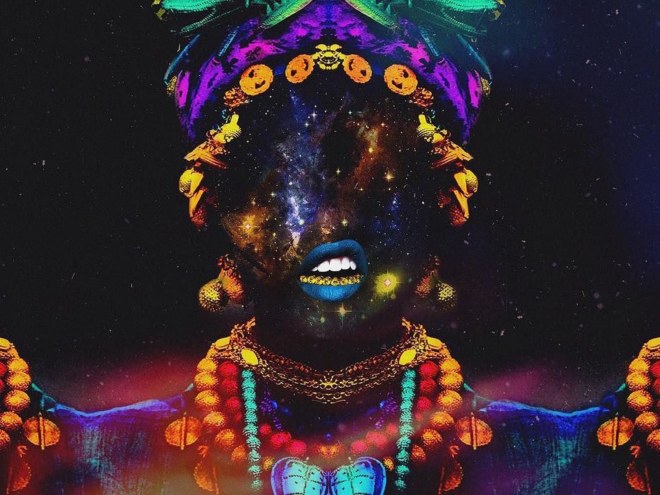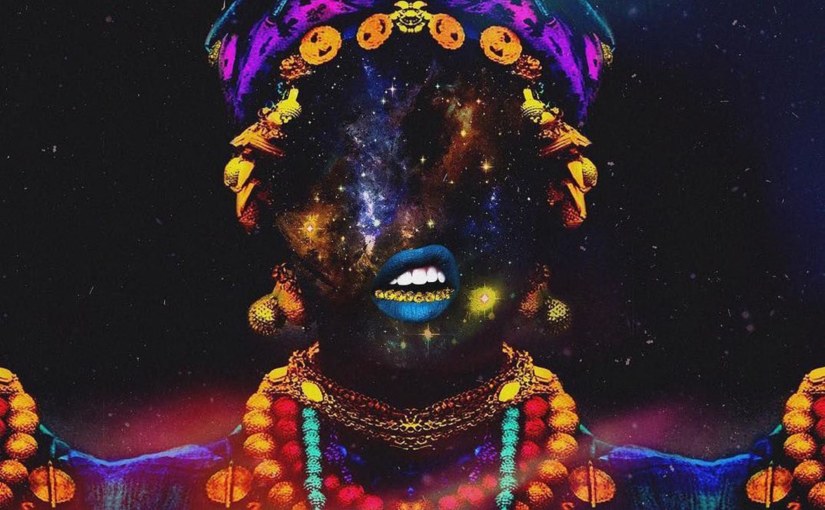When I was younger my uncle was afraid of the O2 Arena – which back then was known as the Millennium Dome. “Don’t go in there, Melchi – it looks like an alien mothership and Africans don’t mess with no aliens”.
How wrong my uncle was. Growing up there was always this idea that anything to do with technology or science fiction was un-African, so far removed from our traditional and ancestral backgrounds. However, the idea of sci-fi, technological advances wasn’t so far-fetched and now we have a name to give it – Afrofuturism.

Afrofuturism is a cultural aesthetic that draws upon the influences of science-fiction, the future and technology merging that with blackness and black people living in Africa and the diaspora. In short, it would be fitting to describe Afrofuturism as a movement. The movement is there to obstruct, ask questions and combat, head on, the past of black people – especially those taken as slaves to America.
Its roots stretch as far back as the late 1950s with American jazz musician Sun Ra and the Arkestra, and sci-fi literature written by W. E. B. Du Bois and George S. Schuyler, however the term itself wasn’t coined until 1993 by American cultural critic Mark Dery in his essay Black to the Future.
Sun Ra was creating music that was not only futurist in sound, but in look, his aesthetic was a fusion of space and ancient Egyptian iconography – something that would become very popular with musicians in the late ‘80s and early ‘90s with the Jonzun Crew, Afrika Bambaataa & The Zulu Nation and Parliament-Funkadelic all adopting the ‘space-age’ look mixed with traditional African elements.
It’s found in black music, art, literature and film. What Afrofuturism does is explore the ideas of blackness and black life from an extraordinary angle. It moves away from the tropes of slavery, baby mother/daddy dramas, crime and other stereotypes and places black people in narratives of which we’ve always been left out.
However, Afrofuturism isn’t just black science fiction – it’s about ancient African traditions, ideals and belief systems and placing it in a context that allows it to exist in the future.
For American artist and academic John Jennings, his introduction into Afrofuturism was accidental, “I did these images about stereotypes, and I came up with this idea of black cyborgs and the constructive identity being metallic. A friend of mine saw these and said, “oh these look afrofuturist” so I looked it up and realised that I was that.”
Jennings has been involved with the movement ever since 2008 and has been integral in this new wave of Afrofuturism over the past decade. “I am very proud to be a part of this new form of what is known as Afrofuturism” he says. One of Jennings’ most notable works includes illustrating the graphic novel adaptation of Octavia E. Butler’s novel Kindred in which an African-American woman married to a white man time travels back to slavery against her will, an experience Jennings described as being “very difficult, but very rewarding and proud to have been a part of.”

When looking at music in Afrofuturism, a lot of it has its basis in genres that are widely accepted as ‘black-founding’; hip-hop, R’n’B, neo-soul, jazz and funk have been the domineering sounds of the movement. However, it would be silly not to suggest the pioneering of house music, especially techno, as afrofuturist.
Berlin-based American DJ and cartoonist Alan Oldham got his start in techno after he was asked by childhood friend and pioneering techno producer Derrick May to create illustrations for his label, Transmat. “It kinda introduced me into the world of Detroit techno…back then it was magical, it was really a thing,” he says.
Hip-hop in its very early stages sounded like early house music, and this sound and this idea of house and techno music as black has been lost now. Oldham says, “black people are defined now by hip-hop…we are limited to these kinds of boxes. With a lot of these younger generations discarding these art forms, the former gets picked up by others.”
There is this idea that black people are monolithic, which is most certainly not true. Oldham tells of the time he was at a family gathering when he met one his younger cousins, “I was introduced to my cousin, and my other relative introduced me as a ‘famous techno DJ’ to which she replied, “isn’t that what all those white folks listen to?” … a lot of people don’t get it – through no fault of their own. It’s kinda tough.”
However, Oldham is confident that we will move towards an afrofuturism that will see more experimental techno music.
It is because of Afrofuturism that artists like Janelle Monáe, Kelela, FKA Twigs and films like Black Panther have been allowed to flourish.
With Black Panther, we are shown a narrative that places an African country at the forefront of technological innovation untouched by colonisation and other negative outside influences. The fictional county of Wakanda is the dream of the ancestors.
For decades black scholars and artists alike had imagined a life where blackness wasn’t seen as a bad thing and where black people could flourish in areas they couldn’t in ‘real life’. Black Panther in a sense echoes the writings of authors like Colson Whitehead who imagined places where black nations had unbounded wealth and a sense of real community untouched by racism and systemic oppressions.
Although Black Panther is fictional, both Jennings and Oldham recount the sentiments of unity the film had inspired. “the emotional and cultural gains are far reaching because it means so much for someone to see someone who looks like them or like someone they know – it’s empowering” Jennings said.
Although African American in its approach Afrofuturism has found its way back to the continent of Africa, for Jennings – this is an exciting prospect, “our brothers and sisters from the diaspora – they want in they’re like hey! I got dreams too, what are we going to do together?” he says; however, he knows that there is some sort of push back against that but says that “this is the beauty of these things, we don’t have to agree all the time. But it is beautiful to see people from Africa interested in this work and engaging.”
The likes of Kenyan artist Osborne Macharia, Burkina Faso architect Diébédo Francis Kéré and Senegalese fashion designer Selly Raby Kane are all influencers of Afrofuturism in Africa and are all respected.

There is a distinct story that Afrofuturism sets out to tell. There’s an idea of reclaiming an identity, one that was so brutally and forcibly erased from black people and using this identity alongside ideas of technology to create something new. What Afrofuturism allows is for those who engage with it to ask questions, try to reconcile themselves with the past and to move forward in positive ways that would ultimately bring about some sort of accord among black African nations and their descendants.
The future is black, the future is Afro.






